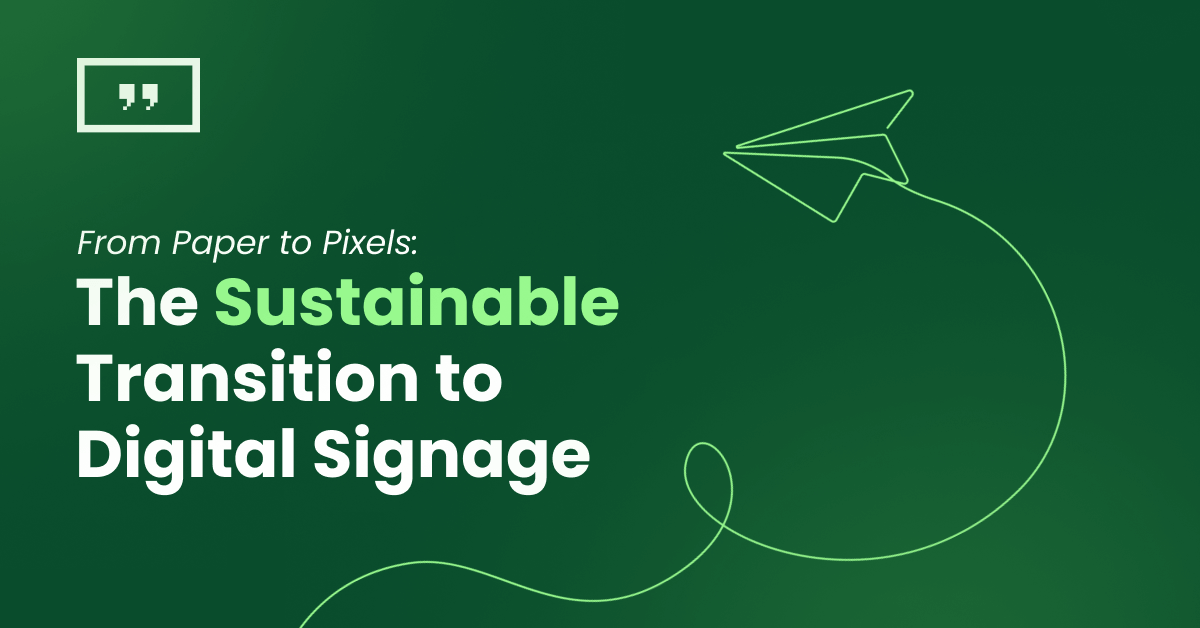All you need to know about sustainable digital signage in a comprehensive read that celebrates this year’s Earth Day.
Today sustainability is no longer just a buzzword. It’s a business imperative. Companies across the globe are seeking innovative ways to minimize their environmental footprint in direct response to consumer requests. Among the myriad technological advancements paving the way for a greener future, digital signage emerges as a standout solution, offering a sustainable alternative to traditional paper-based advertising and communication methods.
What is digital signage?
Let’s start with the basics. What is digital signage?
Quick definition
Digital signage refers to dynamic visual content displayed on electronic screens, typically used for advertising, information dissemination, or as an engagement tool.
Digital signs can be found in various settings like retail stores, corporate offices, public spaces, and transportation hubs and unlike traditional signage, which includes print ads, posters, flyers, and billboards – among other formats – digital signage utilizes LCD, LED, projection, or similar technology to exhibit multimedia content that can be easily updated, is more engaging and offers greater flexibility.
Components of digital signage systems
A typical digital signage system comprises several key components. The display screens (LCD or LED panels), a content management system where the digital content is uploaded, edited, and managed from, media players that push the content to the displays, and the network (wired or wireless) that connects all these elements make up the software and hardware requirements for a digital signage system. Advanced systems might integrate interactive elements as well, such as touch screens, to engage directly with the audience.
Applications of digital signage
Digital signage has a wide array of applications across various sectors. Although the applications of digital signage are too numerous to be extensively listed here, we have gathered a few key areas where digital signs are already transforming businesses and organizations:
- In retail, digital signs can be used for promoting products, in-store branding, and enhancing customer experience.
- In corporate environments, digital signage serves as a dynamic platform for communicating company news, metrics, and employee recognition.
- In public spaces and transportation, it provides real-time information, wayfinding, and public service announcements.
Explore the various applications of digital signage in detail here to fully understand its versatility and utility in reaching diverse audiences in a multitude of contexts.
The environmental impact of traditional signage
To fully appreciate the benefits of digital signage in terms of sustainability, it’s crucial to recognize the complex and often overlooked environmental toll of traditional signage.
Resources, logistics, and energy consumption
Paper-based signage, including banners, posters, and flyers, relies heavily on timber and, to a lesser extent, plastic and other oil derivatives. It also involves the use of chemicals and dyes that further escalate their ecological footprint. This puts extra pressure on natural resources such as trees, water, and energy, while – at the same time – sustaining the ever expanding dependency on fossil fuels.
The production of paper signage is not only resource-intensive but also generates significant waste and greenhouse gas emissions. Along with its demanding production, traditional signage comes with significant resource-intensive logistics. Transportation, distribution, deployment and disposal processes represent additional critical environmental concerns.
This complex conundrum underscores the urgency for sustainable alternatives, both in terms of an organization’s sustainability efforts and its environmentally outward image.
A wasteful tradition
The lifecycle of these traditional materials remains inherently short-lived. Due to the ever-accelerating pace at which information flows and market trends change, businesses today update their promotional materials with an unprecedented frequency. Seasonal promotions are becoming shorter, and special-day events and pop-up activations are pushing the pace of creating, distributing, and deploying advertising material at a remarkable rate.
Today it has become commonplace for stores like supermarkets and fast food restaurants to refresh their signage even multiple times per day. Just think about how happy hours and fast moving promotions need to be timely communicated during a single day, and you start to see the amounts of waste piling up.

A sustainable and eco-friendly alternative
How is digital signage eco-friendly?
By utilizing energy-efficient LED technology, digital signage offers a more sustainable alternative to traditional signs that also significantly curbs paper waste, reduces ink usage, and cuts down on the logistics of physical print advertising. It can also indirectly improve operational efficiency and boost a company’s image. Let’s break these benefits down and see how digital signage makes a compelling case for businesses aiming to reduce their ecological footprint.
Advancements in energy-Efficient technology
Energy consumption is a critical factor in evaluating the sustainability of business practices. Modern digital signage has made significant strides in energy efficiency, particularly with the advent of LED technology. LED displays consume considerably less power than their predecessors and traditional illuminated signage, translating to lower greenhouse gas emissions and reduced operational costs.
Moreover, many digital signs now come equipped with sensors and smart systems that adjust brightness based on ambient light conditions or turn the display off when not in use, further enhancing their energy efficiency.
Environmental footprint
By minimizing energy consumption and reducing waste, sustainable digital signage indirectly contributes to improved air quality and efforts to minimize an organization’s environmental footprint. The energy sector is a major source of air pollution and greenhouse gas emissions; thus, any reduction in energy demand contributes to cleaner air and a slower rate of emissions.
Additionally, by curtailing the use of harmful chemicals and plastics, digital signage helps prevent air and water pollution, aligning with broader environmental protection goals.
Biodiversity protection
The shift to digital signage also has implications for biodiversity protection. Deforestation for paper production not only contributes to carbon emissions but also to the loss of habitat for countless species. By reducing the demand for paper, digital signage indirectly supports the preservation of forests and the biodiversity they harbor. This aspect is particularly important in the context of corporate social responsibility and the growing consumer demand for environmentally respectful business practices.
Waste reduction
One of the most direct environmental impacts of digital signage is its ability to drastically reduce paper waste. By transitioning to digital formats, businesses can eliminate the need for printed materials, thereby conserving forests and reducing waste in landfills. This shift is crucial, considering the extensive water usage and energy consumption involved in paper production, which significantly adds to a business’s carbon footprint.
Beyond paper, traditional signage methods often involve, as already mentioned, various plastics and chemicals, particularly in the production of inks and adhesives. These substances can have detrimental environmental effects, contaminating water sources and contributing to broader pollution issues.
Digital signage, in contrast, eliminates the need for these materials, thereby reducing the release of hazardous chemicals into the environment. Furthermore, the longevity and reusability of digital displays mean that the cycle of production, use, and disposal is considerably extended, diminishing the frequency of waste generation.
Lifecycle and disposal benefits
The environmental benefits of sustainable digital signage extend into its lifecycle and disposal stages. This might seem counterintuitive at first. The production of electronics is an extremely industrialized, resource-heavy process, and electronic waste, highly toxic and not biodegradable, is a major environmental concern.
Nonetheless, the industry is increasingly making big strides in focusing on recyclability and responsible disposal methods. Many components of digital signs can be recycled or repurposed, reducing the need for raw materials and mitigating waste. Furthermore, the durability and upgradability of digital displays ensure a longer lifecycle compared to traditional signs.
As businesses worldwide strive to minimize their environmental impact, adopting digital signage emerges as a pragmatic and impactful strategy. By integrating this technology, companies can not only enhance their sustainability credentials but also contribute to a healthier planet for future generations, making digital signage a truly sustainable choice.
The economics of digital signage
The economics of digital signage also present themselves as both compelling and multifaceted. Digital signage offers businesses and organizations the opportunity to not only enhance their environmental stewardship but also realize significant cost savings and critical operational efficiencies.
By transitioning from traditional print and static signage to digital solutions, organizations can reduce their material and operational expenses, contributing to a healthier bottom line and a more sustainable business model.
Reduced costs
One of the most straightforward economic benefits of digital signage is the reduction in costs associated with the production, distribution, and disposal of traditional print materials. For example, companies that rely heavily on paper-based advertising and communication materials often incur substantial expenses related to sourcing that material.
Additionally, the logistics of distributing, deploying and installing these materials—whether within a single building or across multiple locations—can further inflate expenses. Businesses can eliminate these costs by transitioning to sustainable digital signage, opting instead for a system where content can be updated virtually and instantaneously and without the need for physical production or transportation.
Long-term savings
The advancements of energy efficiency in the technology involved in a digital signage apparatus will translate into a more stable and predictable balance in the long run. Although digital signage requires an initial investment, the reduced recurring costs that come with the transition will result in a better return on investment once the system is wholly and smoothly operational.
The long-term reduced costs also involve any labor costs, either direct or contracted, that come with the logistics involved in traditional signage. Digital signage offers a much more centralized and vertically integrated management of the promotional content where a small number of employees can control and update even thousands of screens with a single dashboard.
Operational advantages
Operational efficiencies are another key economic benefit of digital signage. The ability to update and manage content remotely eliminates the need for personnel to physically replace or update signs and billboards, thereby reducing labor costs and enhancing responsiveness to market changes or communication needs.
On top of that, digital signage has been proven to perform exceptionally in customer engagement. This in turn drives increased revenue through dynamic, targeted content that captures attention more effectively than static displays. This heightened engagement can lead to higher conversion rates and, ultimately, a more robust bottom line.
Indirect gains
The economic benefits of digital signage include not only direct cost savings, but they encompass a range of indirect positive effects as well . They also extend to its ability to enhance a brand’s image and appeal to environmentally conscious consumers. As sustainability becomes increasingly important to customers and regulators, demonstrating a commitment to environmentally friendly practices can bolster a company’s reputation, foster customer loyalty, and even command premium pricing for its products or services.
A well planned and communicated digital transition can signal a business’s commitment to both innovation and sustainability, thus unlocking a crucial competitive advantage.
In conclusion, the economic advantages of digital signage are clear. Digital signage offers a powerful tool as it reduces costs related to materials, energy, and labor while simultaneously enhancing customer engagement and brand reputation. It constitutes an overall smart investment for the future-oriented business.

The real game-changer
We have seen in detail what environmental and economic benefits the transition to digital signage offers, but there are several more nuanced advantages that merit further exploration. These benefits are not only confined to direct environmental impacts or cost savings but also extend to broader business, social, and technological realms, reflecting the multifaceted value of digital signage in contemporary society.
Content management and flexibility
One of the most significant advantages of digital signage over traditional signage is the ease of updating and managing content. Digital content can be changed or updated remotely, centrally and instantly, all from a single dashboard. This replaces the need for costly physical replacement and manual labor.
All in one place
The topic of centrality offers some more not-so-obvious benefits that are worth some further consideration.
A cloud-based solution alleviates the need for extensive investment on servers and IT support and also offers unparalleled accessibility to your content and screens from any location and device.
Moreover, a platform like Yodeck concentrates many more tools than just simply content management. The software comes equipped with its own content creation tools such as free templates, stock content libraries, and a host of third party apps that elevate signs with extra functionality.
The versatility of the platform would not be complete without advanced scheduling capabilities and the ability to add users and workspaces according to the various people and their respective roles in the creation and management of content. This means that even big corporations with advanced needs can maintain an orderly content management strategy within a single platform, even if their screens span across multiple locations.
Agility and responsiveness
The digital nature of these signs allows for swift content updates and adaptability, a crucial advantage in fast-paced environments.
The ability to craft and implement dynamic content strategies, where messages can be tailored to specific audiences, times of day, or special events, significantly enhances the relevance and impact of messaging.
And while content can be instantaneously and automatically changed, digital signage even allows for emergency or critical public service announcements. It can disseminate vital information swiftly, potentially saving lives or mitigating risks. This agility also enables businesses to respond quickly to market trends, news events, or consumer feedback. The transition affords businesses a responsiveness in keeping messaging relevant and timely that could only be made possible in the digital era.
Interactive and engaging customer experiences
Digital signs have the potential to transform passive audiences into active participants. Interactive displays can engage customers in a variety of ways, from touchscreen information kiosks to augmented reality experiences, enhancing customer satisfaction and engagement. This interactivity can also provide direct feedback channels for businesses, fostering a two-way communication stream that can lead to improved campaigns, products, and services.
Making the switch to sustainable digital signage: Considerations and best practices
Transitioning to digital signage represents a clear step towards sustainability. Beyond the operational and economic benefits, the switch to digital signage involves careful consideration and planning in order to ensure that your investment yields the maximum benefits. Here, we delve into key considerations and best practices for businesses looking to adopt digital signage as a sustainable alternative.
Assessing your needs and objectives
Understanding your communication needs and objectives is key before adopting digital signage. Whether you are aiming to reduce paper waste, enhance customer experience and brand image, or streamline your internal communications, defining clear goals, will help you map out a clear path towards your sustainability and business goals.
Choosing the right tech and CMS
On one hand, deciding on the most appropriate physical equipment will go a long way for your transition’s environmental goals. Look for energy-efficient models that use LED or LCD technology, which consume significantly less power than traditional displays. To optimize your setup for energy efficiency, you can also consider displays with ambient light sensors, auto-dimming features, and power-saving modes to further reduce energy consumption.
On the other hand, your choice of content management system is also crucial as this will allow you to automate, craft and monitor your assets’ performance and status remotely and centrally, minimizing costs related to labor and transportation.
Implementing sustainable installation
In order for a successful green campaign, your installation practices should also reflect your sustainability goals. A choice of suppliers and contractors that follow eco-friendly practices can minimize waste during installation and further enhance your brand’s image. Be mindful of screen positioning (avoiding direct sunlight) and electrical installation choices (utilizing power timers) so as to eliminate unnecessary cooling needs and standby power consumption.
Documenting and communicating success
To maximize the effect of the transition on your brand, plan to turn the transformation itself into a brand-positive campaign. Plan a documentation strategy from your current practices to the end result of the digital signage deployment, and include the matter-of-fact numbers in paper reduction, energy consumption, and waste generation. Turn these successes into a communicable campaign to illustrate your commitment to sustainability to your stakeholders and public.
The future is bright
The transition from traditional to digital signage presents itself as a clear path towards a more sustainable positioning for any organization that looks to the future with a clear view. Digital signage offers a myriad of environmental, economic, and operational benefits that can only be temporarily ignored before they become the industry standard. Are you ready for a brighter future?
What you should do now
When you’re ready to take the first step in your transition, here are three ways that Yodeck can help you go greener:
- Book a demo: Our team will show you how easy it is to use Yodeck and answer all your questions.
- If you want to delve deeper into digital signage, visit our Blog and Yodeck Academy. Both are full of use cases, guides and more resources to make you an expert on Yodeck.
- Register to try Yodeck yourself today. Your first screen is forever free!
